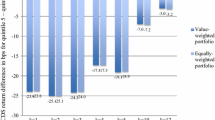Abstract
The evolution of credit derivatives has inspired many researchers to investigate the behaviour of credit spreads. Today the growing consensus is that the equity option market provides sufficient information to estimate latent credit parameters. Hull et al. (J. Credit Risk 1(1):3–28, 2005) propose a clever approach to estimate credit spreads from the equity option market. In this paper we first perform a time series analysis to test the conjecture of an existing relationship between credit spreads and implied equity volatility and find strong evidence of a positive relationship. We also propose an extension to Hull et al.’s paper that significantly improves credit spread estimation.
Similar content being viewed by others
References
Altman, E. (2001). Analyzing and explaining default recovery rates (Working Paper). Stern School of Business, New York, December 2001. http://www.isda.org/c_and_a/pdf/Analyzing_Recovery_rates_010702.pdf.
Black, F., & Cox, J. (1976). Valuing corporate securities: some effects of bond indenture provisions. Journal of Finance, 31, 351–367.
Cathcart, L., & El-Jahel, L. (1999). Pricing defaultable bonds: a middle-way approach between structural and reduced-form models (Working Paper). Imperial College, February 1999.
Chen, C., & Panjer, H. (2003). Unifying discrete structural models and reduced-form models in credit risk using a jump-diffusion process. Journal of Insurance: Mathematics and Economics, 33, 357–380.
Collin-Dufresne, P., & Goldstein, R. (2001). Do credit spreads reflect stationary leverage ratios. Journal of Finance, 56, 1928–1957.
Duffie, D., & Singleton, K. (2003). Credit risk. New Jersey: Princeton University Press.
Elkhodiry, A. (2007). Determining the relationship between the credit and equity markets. University of Toronto.
Eom, Y., Helwege, J., & Huang, J. (2003). Structural models of corporate bond pricing: an empirical analysis (Working Paper). Yonsei University, Ohio State University, Penn State University, April 2003.
Finger, C. (2002). Credit grades technical document. RiskMetrics Group, May 2002.
Finger, C. (2005). Better ingredients. RiskMetrics Group, April 2005.
Gemmill, G. (2002). Testing Merton’s model for credit spreads on zero-coupon bonds (Working Paper). City University Business School, March 2002.
Geske, R. (1977). The valuation of corporate liabilities as compound options. Journal of Financial and Quantitative Analysis, 12, 541–552.
Geske, R. (1979). The valuation of compound options. Journal of Financial Economics, 7, 63–82.
Giesecke, K. (2003). Default and information (Working Paper). Cornell University, April 2003.
Giesecke, K. (2004). Credit risk modeling and valuation: an introduction, (Working Paper). Cornell University, February 2004.
Harrison, J. M. (1990). Brownian motion and stochastic flow systems. Melbourne: Krieger.
He, J., Hu, W., & Lang, L. (2000). Credit spread curves and credit ratings (Working Paper). Chinese University of Hong Kong.
Hull, J., Predescu-Vasvari, M., & White, A. (2004). The relationship between credit default swap spreads, bond yields, and credit ratings announcements. Journal of Banking and Finance, 28, 2789–2811.
Hull, J., Nelken, I., & White, A. (2005). Merton’s model, credit risk, and volatility skews. Journal of Credit Risk, 1(1), 3–28.
Jackwerth, J. C., & Rubinstein, M. (1996). Recovering probabilities from option prices. Journal of Finance, 51, 1611–1631.
Jarrow, R., & Turnbull, S. M. (1995). Pricing derivatives on financial securities subject to credit risk. Journal of Finance, 50, 53–85.
Leland, H., & Toft, K. (1996). Optimal capital structure, endogenous bankruptcy, and the term structure of credit spreads. Journal of Finance, 51, 987–1019.
Liu, S., Lu, J. C., Kolpin, D. W., & Meeker, W. Q. (1997). Analysis of environmental data with censored observations. Environmental Science & Technology, 31.
Lyden, S., & Saraniti, D. (2000). An empirical examination of the classical theory of corporate security valuation. Barclays Global Investors.
Medova, E. D., & Smith, R. G. (2004). Pricing equity default swaps using structural credit models (Working paper). University of Cambridge.
Merton, R. C. (1973). Valuing the down-and-out-call option. The Bell Journal of Economics and Management Science, 4, 141–183.
Merton, R. C. (1974). On the pricing of corporate debt:the risk structure of interest rates. Journal of Finance, 29, 449–470.
Nielsen, L. T. (1993). Understanding N(d1) and N(d2): Risk-adjusted probabilities in the Black-Scholes model. Journal of Finance, 14, 95–106.
Ogden, J. (1987). Determinants of the ratings and yields on corporate bonds: tests of the contingent claims model. Journal of Finance, 10, 329–340.
Sarig, O., & Warga, A. (1989). Some empirical estimates of the risk structure of interest rates. Journal of Finance, 44, 1351–1360.
Zou, J. (2003). The relationship between credit default probability and equity options volatility surface (Working Paper). Morgan Stanley, May 2003.
Author information
Authors and Affiliations
Corresponding author
Rights and permissions
About this article
Cite this article
Elkhodiry, A., Paradi, J. & Seco, L. Using equity options to imply credit information. Ann Oper Res 185, 45–73 (2011). https://doi.org/10.1007/s10479-009-0627-z
Published:
Issue Date:
DOI: https://doi.org/10.1007/s10479-009-0627-z




